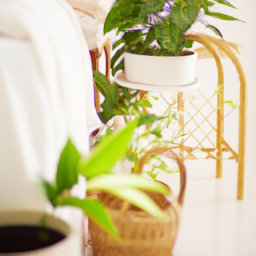
Are you looking to transform your bedroom into a peaceful oasis? Look no further than the power of plants! In this blog post, we will explore the world of best bedroom plants and how they can enhance your sleep, purify the air, and create a serene ambiance. Whether you have a green thumb or are a novice plant parent, incorporating these beautiful and beneficial plants into your bedroom will not only elevate the aesthetics but also improve your overall well-being. So, let’s dive into the wonderful world of best bedroom plants and discover the perfect green companions for your tranquil sanctuary.
Top 5 Bedroom Plants for a Calm and Relaxing Atmosphere
Welcome to our comprehensive guide on the best bedroom plants to create a calm and relaxing atmosphere in your personal sanctuary. Adding plants to your bedroom not only enhances the aesthetics but also offers numerous health benefits. In this article, we will explore the top 5 bedroom plants known for their calming properties, ease of care, and ability to purify the air.
1. Lavender
Lavender, with its enchanting fragrance and beautiful purple flowers, is a popular choice for creating a serene bedroom environment. This aromatic herb has been used for centuries to promote relaxation and improve sleep quality. Lavender plants thrive in well-draining soil and require ample sunlight, making them perfect for placing near windows.
To enjoy the calming benefits of lavender, consider placing a small potted plant on your nightstand or near your bed. The gentle scent of lavender can help reduce anxiety, lower heart rate, and improve sleep quality. Additionally, lavender plants are easy to care for, requiring moderate watering and occasional pruning to maintain their shape.
When it comes to enhancing your bedroom’s ambiance, lavender is a top choice that provides both visual beauty and a soothing fragrance.
2. Snake Plant
If you’re looking for a low-maintenance plant that not only adds a touch of green to your bedroom but also improves air quality, the snake plant is an excellent option. Also known as Sansevieria or mother-in-law’s tongue, this plant is known for its ability to filter toxins from the air, releasing oxygen at night.
The snake plant thrives in low light conditions and requires minimal watering, making it a perfect choice for those who are new to plant care or have limited access to natural light in their bedrooms. Its long, upright leaves add a sense of tranquility to any space, and its air-purifying properties can contribute to a healthier indoor environment.
Consider placing a snake plant in a corner of your bedroom or on a shelf to enjoy its calming presence and air-purifying benefits.
3. Peace Lily
The peace lily is not only visually appealing but also known for its ability to improve air quality by removing toxins like formaldehyde, benzene, and carbon monoxide. This elegant plant features glossy, dark green leaves and beautiful white flowers, creating a serene atmosphere in any bedroom.
Peace lilies prefer indirect light and moderate watering. They are relatively low maintenance and can thrive in various temperature conditions, making them suitable for bedrooms with different climates. However, it’s important to note that peace lilies are toxic to pets if ingested, so it’s best to keep them out of reach of curious animals.
Adding a peace lily to your bedroom not only enhances the aesthetic appeal but also contributes to cleaner and fresher air, promoting a calm and relaxing environment.
4. Aloe Vera
Aloe vera, known for its soothing gel and medicinal properties, is an excellent choice for a bedroom plant. This succulent plant requires minimal care and thrives in bright, indirect light. Its fleshy leaves store water, allowing it to withstand periods of neglect or inconsistent watering.
Aside from its low maintenance nature, aloe vera also offers several health benefits. The gel inside its leaves has natural cooling properties, which can be beneficial for those with skin irritations or sunburns. Breathing in the oxygen released by aloe vera at night can also help improve sleep quality.
Consider placing an aloe vera plant on your bedroom windowsill or a nearby table to enjoy its calming presence and potential health benefits.
5. English Ivy
English ivy is a versatile and visually appealing plant that can thrive in a variety of conditions, making it a popular choice for bedroom decor. Its cascading vines and lush green leaves create a calming and natural ambiance in any space. Additionally, English ivy is known for its ability to filter airborne toxins, including mold spores, making it an excellent choice for improving indoor air quality.
This plant prefers moderate to bright indirect light and requires regular watering to keep the soil moist. English ivy can be grown in hanging baskets or placed on shelves, allowing its vines to gracefully cascade down, adding a touch of elegance to your bedroom.
Before introducing English ivy to your bedroom, it’s essential to note that it can be toxic to pets if ingested. Therefore, it’s important to keep it out of reach of animals.
In conclusion, incorporating plants into your bedroom decor can greatly enhance the overall ambiance and promote a calm and relaxing atmosphere. The top 5 bedroom plants mentioned in this guide, including lavender, snake plant, peace lily, aloe vera, and English ivy, offer not only aesthetic beauty but also various health benefits. Whether you prefer a fragrant flower, an air-purifying plant, or a low-maintenance succulent, there’s a perfect bedroom plant for everyone. Choose the plants that resonate with you and enjoy the tranquility they bring to your personal sanctuary.
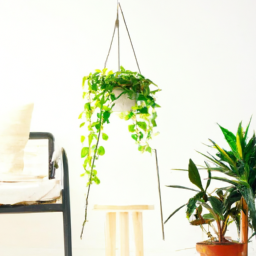
The Best Bedroom Plants for Improving Air Quality and Sleep
Having plants in your bedroom not only adds a touch of nature to your space but also offers numerous benefits for your health and well-being. Certain plants have the ability to improve air quality and promote better sleep, making them ideal choices for your bedroom. In this article, we will explore the best bedroom plants that can enhance the air you breathe and help you achieve a restful night’s sleep.
1. Snake Plant (Sansevieria Trifasciata)
The snake plant, also known as mother-in-law’s tongue, is a popular choice for bedrooms due to its ability to purify the air. This plant is known for its efficient oxygen production, especially during the night. It absorbs carbon dioxide and releases oxygen, making it an excellent choice for improving air quality while you sleep.
Furthermore, the snake plant is a low-maintenance plant that thrives in low light conditions, making it perfect for bedrooms with limited sunlight. Its long, upright leaves add an elegant touch to any bedroom decor. Place a snake plant near your bed to experience its air-purifying benefits and enjoy a more rejuvenating sleep.
When it comes to caring for a snake plant, ensure that you water it sparingly, as overwatering can lead to root rot. Additionally, it is important to avoid exposing the plant to extremely cold temperatures.
2. Aloe Vera (Aloe Barbadensis)
Aloe vera is a versatile plant that not only offers soothing properties for your skin but also helps improve air quality in your bedroom. It releases oxygen at night, making it an excellent choice for enhancing sleep quality. Aloe vera also removes harmful toxins from the air, such as formaldehyde and benzene, which can be found in common household products.
In addition to its air-purifying benefits, aloe vera is easy to care for and requires minimal attention. It thrives in bright, indirect sunlight and prefers well-draining soil. Water your aloe vera plant when the top inch of soil is dry, but be cautious not to overwater, as this can lead to root rot.
Place an aloe vera plant on your bedroom windowsill or a nearby table to enjoy its air-purifying properties while adding a touch of green to your space.
3. Peace Lily (Spathiphyllum)
The peace lily is a beautiful flowering plant that not only enhances the aesthetic appeal of your bedroom but also helps improve air quality. It effectively removes toxins like formaldehyde, benzene, and trichloroethylene from the air, making it a fantastic choice for those with allergies or respiratory issues.
Peace lilies thrive in low light conditions, making them ideal for bedrooms with limited sunlight. However, they do require regular watering to keep the soil moist. Be mindful not to overwater, as this can lead to root rot. Yellowing leaves are a sign of overwatering, while drooping leaves indicate the need for more water.
Place a peace lily on a bedside table or near a window in your bedroom to enjoy its air-purifying benefits and promote a sense of tranquility and relaxation in your sleep environment.
These are just a few of the best bedroom plants that can improve air quality and promote better sleep. Incorporating these plants into your bedroom not only enhances the aesthetics but also contributes to a healthier and more restful sleep environment. Experiment with different plants and find the ones that resonate with you the most. Happy planting and sweet dreams!
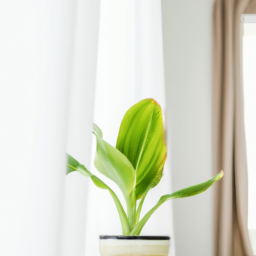
Low-Maintenance Bedroom Plants That Thrive in Various Lighting Conditions
Creating a relaxing and peaceful atmosphere in your bedroom can greatly contribute to a good night’s sleep. One way to achieve this is by incorporating plants into your bedroom decor. Not only do they add a touch of nature and beauty to the space, but they also have numerous health benefits. However, finding the right plants that can thrive in different lighting conditions and require minimal care can be challenging. In this article, we will explore three low-maintenance bedroom plants that are perfect for various lighting conditions.
1. Snake Plant (Sansevieria Trifasciata)
The Snake Plant, also known as Mother-in-Law’s Tongue, is a popular choice for bedrooms due to its ability to purify the air and release oxygen at night. This plant is incredibly resilient and can thrive in a wide range of lighting conditions, from low light to bright indirect light. It is an excellent choice for those who are new to plant care or have limited time for maintenance.
When it comes to watering, the Snake Plant prefers to dry out between waterings, making it ideal for forgetful plant owners. It is important to note that overwatering can lead to root rot, so it’s best to err on the side of underwatering. Additionally, this plant is tolerant of temperature fluctuations, making it suitable for bedrooms that may experience varying temperatures throughout the year.
The Snake Plant has long, upright leaves that come in different varieties, including ones with yellow edges or variegated patterns. It can grow up to several feet tall, adding a dramatic touch to your bedroom decor. Place it near a window or in a corner where it can receive indirect sunlight, and enjoy the beauty and air-purifying benefits it brings to your sleeping space.
2. ZZ Plant (Zamioculcas Zamiifolia)
The ZZ Plant is another low-maintenance option that can thrive in various lighting conditions, making it a perfect choice for bedrooms with limited natural light. This plant has glossy, dark green leaves that add a touch of elegance to any room. It is known for its ability to tolerate neglect and can survive in low light, making it an excellent choice for those who struggle to keep plants alive.
The ZZ Plant has thick, fleshy stems that store water, allowing it to withstand periods of drought. This means that it can go without water for extended periods, making it an ideal choice for those who may forget to water their plants regularly. However, it’s important not to overwater the ZZ Plant, as it is susceptible to root rot. Allow the soil to dry out completely between waterings, and ensure that the pot has proper drainage.
In terms of lighting, the ZZ Plant can tolerate low light conditions but will also thrive in brighter indirect light. Avoid placing it in direct sunlight, as this can scorch the leaves. This plant can grow up to three feet tall, adding a vertical element to your bedroom decor. Its lush foliage and low-maintenance nature make it a perfect choice for those looking to bring a touch of greenery into their sleeping space.
3. Pothos (Epipremnum Aureum)
If you’re looking for a versatile and easy-to-care-for plant that can adapt to different lighting conditions, the Pothos is an excellent choice. Also known as Devil’s Ivy, this plant features heart-shaped leaves that come in various shades of green, making it a visually appealing addition to any bedroom.
The Pothos is known for its ability to thrive in low light conditions, but it can also tolerate brighter indirect light. This makes it a great option for bedrooms with windows that receive varying levels of sunlight throughout the day. However, it’s important to note that intense, direct sunlight can burn the leaves, so it’s best to keep it away from windows with harsh sun exposure.
When it comes to watering, the Pothos prefers to dry out between waterings. It is more forgiving of underwatering than overwatering, so it’s best to let the soil dry out partially before watering again. This plant can also be grown in water, making it a popular choice for those who want to display it in a vase or jar filled with water.
The Pothos is a trailing plant that can be placed on a shelf, hung from a macrame hanger, or displayed on a tall plant stand. Its cascading vines add a touch of elegance and charm to any bedroom. With its adaptability to different lighting conditions and low-maintenance care requirements, the Pothos is a top choice for those looking to incorporate plants into their sleeping space.
In conclusion, incorporating low-maintenance bedroom plants that thrive in various lighting conditions can enhance the ambiance and air quality of your sleeping space. The Snake Plant, ZZ Plant, and Pothos are all excellent choices that require minimal care and can adapt to different lighting conditions. Whether you have a brightly lit bedroom or one with limited natural light, these plants will bring beauty and tranquility to your sleeping space. Remember to consider the specific needs of each plant and provide them with the appropriate care to ensure their growth and longevity. Happy plant parenting!
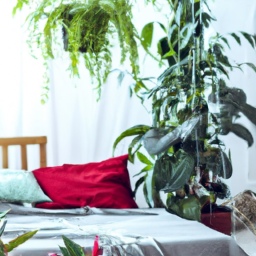
Best Bedroom Plants for Reducing Stress and Promoting Mental Well-being
Creating a calm and peaceful environment in your bedroom is crucial for reducing stress and promoting mental well-being. One effective way to achieve this is by incorporating plants into your bedroom decor. Not only do plants add a touch of natural beauty, but they also have numerous benefits for your overall health and well-being. In this article, we will explore the best bedroom plants that can help you reduce stress and improve your mental well-being.
1. Lavender (Lavandula angustifolia)
Lavender is widely known for its calming and soothing properties. Its delightful fragrance has been used for centuries to promote relaxation and improve sleep quality. By placing a pot of lavender in your bedroom, you can create a peaceful atmosphere that helps you unwind after a long day.
In addition to its aromatic benefits, lavender also has scientifically-proven effects on reducing stress and anxiety. Studies have shown that the scent of lavender can lower heart rate and blood pressure, inducing a state of relaxation. It can also improve the quality of sleep, making it an ideal plant for those struggling with insomnia or other sleep disorders.
To care for lavender, make sure it receives plenty of sunlight and well-drained soil. Water it moderately, allowing the soil to dry out between waterings. With proper care, your lavender plant will thrive and continue to provide you with its calming effects.
2. Snake Plant (Sansevieria trifasciata)
The snake plant, also known as mother-in-law’s tongue, is a popular choice for bedrooms due to its ability to purify the air. This plant is highly effective in removing toxins such as formaldehyde, benzene, and xylene from the air, which can improve the overall air quality in your bedroom.
In addition to its air-purifying qualities, the snake plant also releases oxygen at night, making it an excellent choice for improving sleep quality. It can help reduce allergies and respiratory problems, allowing you to wake up feeling refreshed and rejuvenated.
Snake plants are low-maintenance and can thrive in various lighting conditions, from bright light to low light. They prefer well-drained soil and should be watered sparingly, as overwatering can lead to root rot. With its unique appearance and air-purifying benefits, the snake plant is a fantastic addition to any bedroom.
3. Aloe Vera (Aloe vera)
Aloe vera is a versatile plant that offers numerous health benefits. It is well-known for its soothing properties and is often used to treat skin conditions such as burns and sunburns. However, aloe vera is not just beneficial for external use; it can also improve your indoor environment.
Aloe vera releases oxygen at night, similar to the snake plant, making it an excellent choice for enhancing sleep quality. It also helps purify the air by removing toxins like formaldehyde and benzene. Additionally, aloe vera plants are relatively easy to care for, making them perfect for those with a busy lifestyle.
To care for your aloe vera plant, place it in a location with bright, indirect sunlight. Allow the soil to dry out between waterings, as overwatering can lead to root rot. With its air-purifying properties and low maintenance requirements, aloe vera is an excellent choice for a bedroom plant.
4. Peace Lily (Spathiphyllum)
The peace lily is not only a beautiful plant but also a powerful air purifier. It effectively removes toxins such as formaldehyde, benzene, and trichloroethylene from the air, improving the overall air quality in your bedroom. This can have a significant impact on your respiratory health and overall well-being.
In addition to its air-purifying qualities, the peace lily also adds a touch of elegance to any bedroom decor. Its white flowers and glossy green leaves create a calming and serene atmosphere, perfect for promoting relaxation and reducing stress.
Peace lilies thrive in low to medium light conditions and prefer slightly moist soil. However, be cautious not to overwater them, as they can be sensitive to excessive moisture. With proper care, your peace lily will flourish and provide you with its aesthetic and health benefits.
By incorporating these best bedroom plants into your living space, you can create a tranquil environment that promotes relaxation, reduces stress, and improves your overall mental well-being. Remember to choose plants that suit your lifestyle and preferences, and always provide them with the care they need to thrive. Enjoy the benefits of nature right in the comfort of your own bedroom!
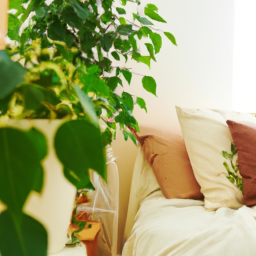
Trending Bedroom Plants: Discover the Latest Greenery for a Stylish and Serene Space
Welcome to our comprehensive guide on the best bedroom plants to create a stylish and serene space. In this article, we will explore the latest trends in greenery for your bedroom, providing you with an analytical perspective on the benefits of incorporating plants into your sleeping sanctuary.
The Importance of Bedroom Plants
Plants not only add a touch of natural beauty to your bedroom but also offer numerous benefits for your overall well-being. They have the ability to purify the air, increase humidity levels, and reduce stress, promoting a peaceful and restful sleep. Additionally, plants can enhance the aesthetics of your space, creating a serene and inviting atmosphere.
When selecting bedroom plants, it is important to consider their specific characteristics and needs. Some plants require more sunlight, while others thrive in low-light conditions. Understanding these requirements will help you choose the best plants that will thrive in your bedroom environment.
Without further ado, let’s dive into the trending bedroom plants that are currently captivating plant enthusiasts worldwide.
1. Snake Plant (Sansevieria trifasciata)
The Snake Plant, also known as Sansevieria or Mother-in-Law’s Tongue, is a popular choice for bedrooms due to its low maintenance and air-purifying qualities. It can thrive in both bright and low-light conditions, making it suitable for various bedroom environments.
One of the unique features of the Snake Plant is its ability to convert carbon dioxide into oxygen at night, making it an ideal plant for improving air quality while you sleep. Its long, upright leaves add a touch of elegance to any bedroom decor, and its architectural shape makes it a trendy choice for modern and minimalist spaces.
When caring for a Snake Plant, it is important to avoid overwatering as it can lead to root rot. Allow the soil to dry out between waterings and place the plant in a well-draining pot.
2. Peace Lily (Spathiphyllum)
The Peace Lily is not only a visually stunning plant but also an excellent choice for bedrooms due to its ability to purify the air and increase humidity levels. Its beautiful white flowers and glossy green leaves create a tranquil and serene atmosphere, perfect for promoting relaxation and a good night’s sleep.
This plant thrives in low to moderate light conditions, making it suitable for bedrooms with limited sunlight. It is important to keep the soil slightly moist but not overly wet, as overwatering can lead to root rot. The Peace Lily is also known to be sensitive to chemicals, so avoid using harsh cleaning products near the plant.
With its air-purifying qualities and elegant appearance, the Peace Lily is a popular choice for bedrooms seeking a touch of sophistication and tranquility.
3. Pothos (Epipremnum aureum)
The Pothos plant, also known as Devil’s Ivy, is a versatile and easy-to-care-for plant that can thrive in various lighting conditions. It is an excellent choice for bedrooms with limited sunlight, as it can tolerate low-light environments and still maintain its vibrant green foliage.
One of the key benefits of the Pothos plant is its ability to remove toxins such as formaldehyde, benzene, and xylene from the air, promoting a healthier indoor environment. Its trailing vines make it a perfect choice for hanging baskets or placing on shelves, adding a touch of natural beauty to your bedroom decor.
When caring for a Pothos plant, allow the soil to dry out between waterings and avoid overwatering, as it can lead to root rot. This plant is relatively low-maintenance and forgiving, making it an ideal choice for beginners or those with a busy lifestyle.
4. Rubber Plant (Ficus elastica)
The Rubber Plant is a popular choice for bedrooms due to its large, glossy leaves and ability to thrive in low to moderate light conditions. Its striking foliage adds a touch of drama and elegance to any bedroom, making it a statement piece in your greenery collection.
This plant is known for its air-purifying qualities, removing toxins such as formaldehyde from the air, and increasing humidity levels. It is important to place the Rubber Plant away from drafts and avoid sudden temperature changes, as it can lead to leaf drop.
When caring for a Rubber Plant, water it thoroughly and allow the top inch of soil to dry out before watering again. This plant appreciates regular misting to increase humidity levels, especially during dry winter months.
5. ZZ Plant (Zamioculcas zamiifolia)
The ZZ Plant is a trendy and resilient choice for bedrooms, known for its glossy green leaves and ability to thrive in low-light conditions. It is an excellent choice for bedrooms with limited sunlight, as it can tolerate neglect and still maintain its beauty.
This plant has the ability to remove toxins such as xylene and toluene from the air, contributing to a healthier indoor environment. Its upright growth habit and architectural shape make it a stylish addition to any bedroom decor.
When caring for a ZZ Plant, allow the soil to dry out completely between waterings, as overwatering can lead to root rot. This plant is drought-tolerant and can withstand periods of neglect, making it a perfect choice for those who may forget to water their plants regularly.
In conclusion, incorporating bedroom plants into your sleeping sanctuary not only adds a touch of natural beauty but also offers numerous benefits for your overall well-being. The trending bedroom plants mentioned above are excellent choices for creating a stylish and serene space. Remember to consider the specific needs and characteristics of each plant to ensure they thrive in your bedroom environment. Happy greening!
Crisp Recap
Adding plants to your bedroom not only enhances the aesthetic appeal but also offers numerous health benefits. In this blog post, we will explore the best bedroom plants that can transform your sleeping space into a tranquil oasis.
First on the list is the Snake Plant, also known as Mother-in-Law’s Tongue. This low-maintenance plant releases oxygen at night, making it an ideal choice for bedrooms. It also filters out harmful toxins, improving air quality and promoting better sleep. Another excellent option is the Peace Lily, which not only adds a touch of elegance but also acts as a natural humidifier, reducing the risk of dry skin and respiratory issues. Additionally, this plant is known for its ability to remove toxins like formaldehyde and benzene from the air.
For those seeking a pop of color, the Spider Plant is an excellent choice. It is known for its air-purifying qualities and is particularly effective at removing carbon monoxide and formaldehyde. Moreover, its vibrant green leaves can instantly uplift the ambiance of any bedroom. Other noteworthy bedroom plants include the Aloe Vera, which offers soothing properties and helps improve air quality, and the English Ivy, which can reduce airborne mold spores and enhance sleep quality. By introducing these plants to your bedroom, you can create a serene and healthy environment conducive to a restful night’s sleep.
Common Questions and Answers:
Q1: What are the benefits of having plants in the bedroom?
A1: Having plants in the bedroom can improve air quality by increasing oxygen levels and reducing toxins. They can also help create a calming and relaxing environment, improve sleep quality, and add aesthetic appeal to your bedroom.
Q2: Which plants are best suited for the bedroom?
A2: Some of the best bedroom plants include the Snake Plant (Sansevieria), Peace Lily (Spathiphyllum), Spider Plant (Chlorophytum comosum), Aloe Vera, English Ivy (Hedera helix), and Bamboo Palm (Chamaedorea seifrizii). These plants are known for their ability to purify the air and thrive in low-light conditions.
Q3: How do bedroom plants improve air quality?
A3: Bedroom plants improve air quality by absorbing carbon dioxide and releasing oxygen through photosynthesis. They also help remove harmful toxins such as formaldehyde, benzene, and trichloroethylene from the air, making it healthier to breathe.
Q4: Do bedroom plants require a lot of maintenance?
A4: Not all bedroom plants require extensive maintenance. Some plants, like the Snake Plant and ZZ Plant (Zamioculcas zamiifolia), are known for their low-maintenance nature and can thrive with minimal care. However, it’s important to provide adequate light, water, and occasional fertilization to ensure the health and longevity of your plants.
Q5: Can bedroom plants help improve sleep quality?
A5: Yes, certain bedroom plants can help improve sleep quality. Plants like Lavender (Lavandula), Jasmine (Jasminum), and Valerian (Valeriana officinalis) have soothing scents that can promote relaxation and better sleep. Additionally, plants release oxygen at night, which can improve air quality and create a more restful environment.
Q6: How much light do bedroom plants need?
A6: The light requirements for bedroom plants vary depending on the species. While some plants thrive in bright, indirect light, others can tolerate low-light conditions. It’s important to choose plants that are suitable for the available light in your bedroom and place them accordingly.
Q7: Can bedroom plants be harmful to pets?
A7: Some plants can be toxic to pets if ingested. It’s important to choose pet-friendly plants for your bedroom if you have pets. Avoid plants like the Peace Lily, Snake Plant, and Aloe Vera, as they can be toxic to cats and dogs. Always research the toxicity of plants before bringing them into a pet-friendly environment.
Q8: How do I water bedroom plants properly?
A8: Proper watering depends on the specific plant’s needs. It’s essential to avoid overwatering or underwatering your bedroom plants. Most plants prefer slightly moist soil, so it’s best to check the moisture level by sticking your finger into the soil. Water the plant when the top inch of soil feels dry, but avoid letting the plant sit in standing water.
Q9: Can I keep bedroom plants even if I don’t have a green thumb?
A9: Absolutely! There are many low-maintenance bedroom plants that are perfect for beginners or those without a green thumb. Plants like the Spider Plant, Pothos (Epipremnum aureum), and Chinese Evergreen (Aglaonema) are known for their resilience and ability to tolerate neglect. With proper placement and minimal care, anyone can enjoy the benefits of bedroom plants.
Q10: Where can I buy bedroom plants?
A10: Bedroom plants can be purchased from various sources. You can find them at local nurseries, garden centers, or home improvement stores. Online retailers and plant delivery services also offer a wide selection of bedroom plants. Additionally, consider checking out local plant swaps or asking friends and family if they have any cuttings or extra plants to share.
Dr. Olivia Green is a botanist with over two decades of experience in indoor plant cultivation. She holds a Ph.D. in Plant Biology and has dedicated her career to researching plant behavior in controlled environments. Dr. Green is passionate about helping plant enthusiasts master the art of indoor gardening through her extensive knowledge and practical insights.


